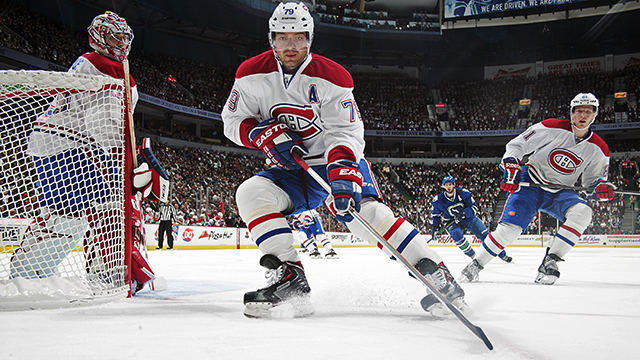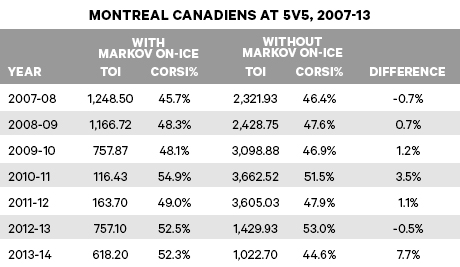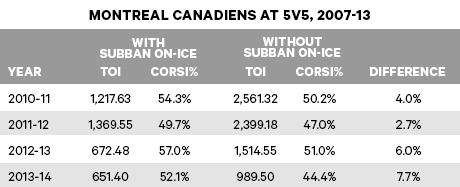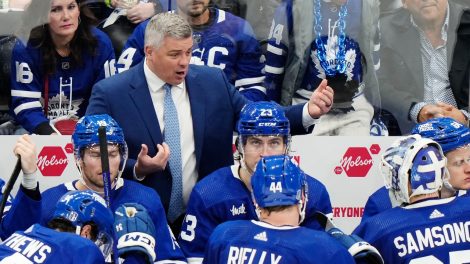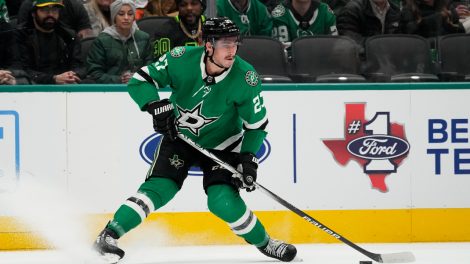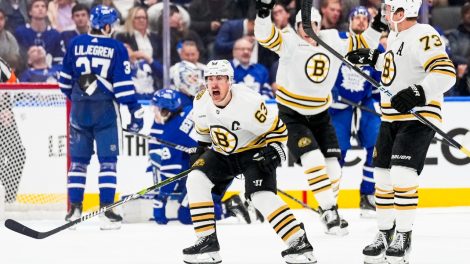One of the great truisms of hockey punditry since Lockout II in 2004–05 is that Andrei Markov makes mediocre defencemen look like stars. The theory is that they play with Markov, look really impressive, get paid big money to go somewhere else and then don’t live up to their contracts.
This phenomenon undoubtedly exists with some players. Whenever Joe Thornton retires, Glen Murray, Jonathan Cheechoo, Patrick Marleau and Bill Guerin ought to buy him something really nice because they earned a lot of money being on the receiving end of his passes.
If you go back and look, you find stuff like Murray scoring 0.48 goals/game during the 258 games he played in Boston when Thornton was a Bruin and 0.28 goals/game during the rest of his career. Cheechoo had seven goals in his first 24 games in 2005–06, but he scored 46 goals in his final 58 games with Thornton picking up assists on 39 of those goals. Marleau scored 39 power play goals in 558 games before Thornton got to town, a goal every 15 games or so. Since then, he’s scored 91 power play goals in 617 games, a goal every seven games. It’s not all Thornton but, with really great players, you see things like this: They switch teams and suddenly their new teammates enjoy notable spikes in performance.
Nobody’s saying that Markov’s in Thornton’s class but still: Markov has a reputation as a guy who makes other players better, to the point that they’re crushing disappointments when they leave his side. If this is real, we should be able to find evidence that supports it.
Let’s start with something simple. Do the Canadiens get a higher share of the total shot attempts (Corsi%) when Markov is on the ice than when he isn’t?
As you can see, Markov’s missed a lot of time due to injury—from 2009–12, he played in just 31 percent of Montreal’s games. Outside of this year, he doesn’t seem to have been a particularly big difference maker for Montreal in terms of 5v5 shot attempts. The Canadiens are about as good when he’s on the ice as they are when he’s not.
This year is a bit unusual because of the identity of Markov’s defensive partner for the vast majority of the minutes that he’s played—P.K. Subban. Subban is the real deal.
Subban (who should be an absolute no-brainer for the Canadian Olympic team) has been a large difference maker for Montreal in each of his four full seasons, with his impact growing in the last two seasons. Markov’s spent 85 percent of his time on the ice with Subban this year compared to about 12.5 percent of his TOI in Subban’s first three full seasons in Montreal. The smart money’s not on Markov being the magic in that pairing.
Looking at this data, it’s tough to argue that Markov is a difference maker at 5v5. But 5v5 play probably isn’t the strongest part of Markov’s case: It’s his results on the PP. From 2007–13, the Habs scored about 8.3 goals per 60 minutes of Markov’s 5v4 time, the fourth best number of any defenceman in the NHL with at least 1,000 minutes of 5v4 time in that window. It’s a pretty solid data point in support of his case as a special defenceman.
But how much was it a direct result of Markov’s play? As always, the trick lies in pulling the data apart and applying some reason. Why did Montreal score so many goals with Markov on the ice at 5v4? Was it shooting percentage? Shot volume? Both? We can look into that by comparing the Habs’ shot rates and shooting percentage with Markov on the ice at 5v4 against what happened when he wasn’t on the ice. Samples are small with 5v4 TOI, so I’m going to present global numbers and weight the seasons that Markov was injured less heavily.
There’s a slight edge in the 5v4 shot rate with Markov on the ice but it’s not particularly significant. Moreover, doing a 5v4 comparison is a little different than a 5v5 comparison. At 5v5, defencemen spend time playing with all of the forwards on the team. At 5v4, defencemen who are seen as elite power-play guys tend to play a much higher percentage of their time with the best 5v4 players on the team. That difference of three shots per 60 minutes isn’t just the difference between Markov and whoever the Canadiens played on their second unit—it’s the difference between the team’s best players at 5v4 as identified by the coach and the next five.
The real difference lies in the fact that the Canadiens shot 15.8 percent with Markov on the ice and 11.3 percent when he wasn’t on the ice. Again, that’s not going to be all Markov—if he was playing with Montreal’s best players at 5v4, we’d expect them to score at a higher rate. It’s probably also somewhat lucky—of the 42 defencemen who played at least 1,000 minutes at 5v4 from 2007–13, nobody was within a percentage point of Markov’s 15.8 percent in terms of their shooting percentage when they were on the ice.
One of the things that’s emerged as people have looked at hockey data is just how unlikely a high on-ice shooting percentage is to persist. If something doesn’t persist, analytically minded people tend to think of it not as the result of a skill but as being somehow related to luck. Sometimes you get the bounces; sometimes you don’t.
If you’re uncomfortable with this sort of an explanation and want to believe that Markov somehow creates a high shooting percentage when he’s on the ice, there’s another way to look at it. The Habs scored 160 5v4 goals with Markov on the ice between 2007–13. Markov had 87 points. So on 73 of the goals scored when he was on the ice, Markov either wasn’t one of the last three Canadiens to touch the puck or the other team possessed the puck between his last touch and the PP goal.
You can add to that the fact that 30 of Markov’s 64 assists were second assists. How often do you watch a goal and think, “The goal scorer would never have had that easy tap-in were it not for the guy credited with the second assist?” It’s simply not how the game works. If you think that Markov was driving the Canadiens’ shooting percentage at 5v4 to extraordinarily high levels, you have to come up with a theory that accounts for the fact that he only scored or had a first assist on about 36 percent of the 5v4 goals. Chance, or playing with extraordinarily gifted teammates on the PP, seems a better explanation. But either way, it doesn’t seem like it would have anything to do with Markov.
Markov’s 4v5 play doesn’t really warrant much mention–he has not stood out relative to his teammates. What does it all add up to then? A defenceman who doesn’t really out-perform his team at 5v5 unless paired with Subban and who has had some success at 5v4 that was driven by shooting percentage. His results do not suggest the sort of player who is a difference maker at this stage of his career—if he ever was.
Markov is being paid $5.75 million this season and his contract expires at the end of the year. He’s exactly the sort of player that a clever team might sell high on, realizing that he doesn’t seem to have a big impact on the results—not unlike what San Jose did with Douglas Murray at the trade deadline last year.

